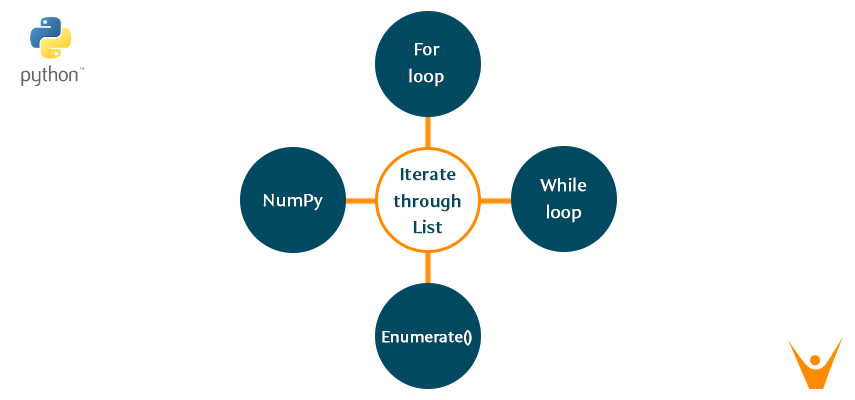In this article, we will study what is a list in python language and different ways to iterate through a list in python programming along with the python code for the same. So, let’s start!
What is a List in Python?
List in python language is used to store multiple elements in a single variable. Lists are one of the 4 data types in python language along with tuple, set, and dictionary. List in Python is created by putting elements inside the square brackets, separated by commas. A list can have any number of elements and it can be of multiple data types. Also, all the operation of the string is similarly applied on list data type such as slicing, concatenation, etc. Also, we can create the nested list i.e list containing another list.
6 Ways to Iterate through a List in Python
There are multiple ways through which we can iterate the list in python programming. Let us study them one by one below:
Using for loop
The easiest method to iterate the list in python programming is by using them for a loop. The method of the iterating list using for loop is as given below
list = [1, 2, 3, 4, 5] # Iterating list using for loop for i in list: print(i)
The output of the above code is as given below:
1
2
3
4
5
Using loop and range() function
Another method to iterate the list while programming in python is by using the loop and range() function together. Iterating the list using this method is not recommended if iteration using for loop(method 1) is possible. The method to do so is as given below:
list = [1, 2, 3, 4, 5] # getting length of list using len() function length = len(list) # using for loop along with range() function for i in range(length): print(list[i])
The output of the above code is as given below:
1
2
3
4
5
Using While loop
We can also iterate the list in python language using a while loop. The method to use while loop for the iterating list is as given below:
list = [1, 2, 3, 4, 5] # Getting length of list using len() function length = len(list) i = 0 while i < length: print(list[i]) i += 1
The output of the above code is as given below:
1
2
3
4
5
Using list comprehension
This is the most concrete way to iterate the list while programming in the python language. The method to iterate list using list comprehension is as given below:
list = [1, 2, 3, 4, 5] # Iterating list using list comprehension [print(i) for i in list]
The output of the above code is as given below:
1
2
3
4
5
Using enumerate() function
There are few times when you may need the display the index of the element along with the element in the list itself. In such cases, we use the enumerate() function for the iteration of the list. The method to use the enumerate() function to iterate the list is as given below:
list = [1, 3, 5, 7, 9] # Using enumerate() function to iterate the list for i, val in enumerate(list): print (i, ",",val)
The output of the above code is as given below:
0, 1
1, 3
2, 5
3, 7
4, 9
Using Numpy function
All the methods that we discussed till now are generally preferable for small or say single-dimensional lists. But when it comes to large n-dimensional lists it is advisable to use an external library such as NumPy for iterating lists. The method to use the Numpy function for iterating lists is as given below:
# Importing external library import numpy as np a = np.arange(5) for x in np.nditer(a): print(x)
The output of the above code is as given below:
0,
1
2
3
4
Conclusion
Therefore, in this article, we studied what is the list in python programming and different methods to iterate the list while programming in python. Also, we learned the code to use that method by an example and its respective output.








